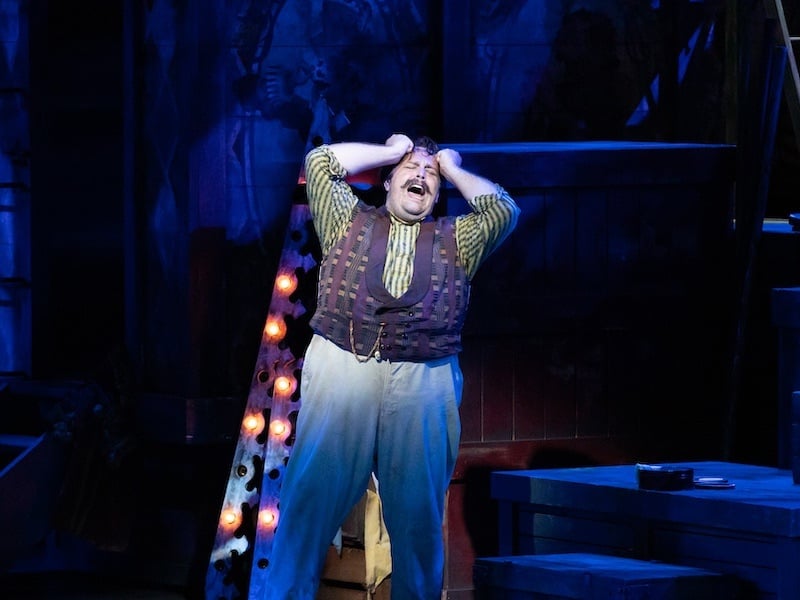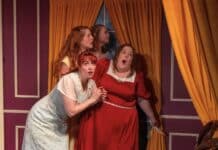There is a theory that the ear, like the heart, is most happily satisfied moving between the known and the unknown then back to the known. Hence, music that returns to a familiar refrain is considered food for the soul. Does programming an opera season also bring an opportunity for pairing such complementarity? The old and the new — two operas in production in this year’s Glimmerglass Festival season, Pagliacci and Elizabeth Cree — would they somehow speak to each other, though separated by more than 150 years in conception, and resonate with an audience today?
Both operas are wrapped in stories of domestic tension, revenge, and murder. Both have memorable central characters compelled by dark psychological motivations. Both use a framing device as a kind of prologue, where the audience is made privy to the end of the story so that we might better revisit the series of events leading up to their tragic endings. Perhaps, of greatest relevance to today’s conversation, at the center of both these stories is a female character stuck in a loveless marriage. One is led to ask, even plea, “Why don’t you get out? Run away?!”

What makes Pagliacci such a mainstay in the opera canon is the music by Ruggero Leoncavallo, who also penned his own libretto. In particular, there is the heartbreaking refrain the composer returns to again and again. “Ridi, Pagliaccio,” the clown Canio sobs. “Laugh, First Clown!” he commands, or as some children have made themselves familiar with the ad version of the central musical motif, by singing, “No more Rice Krispies! We’ve run out of Rice Krispies!”
The Pagliacci story refers to a traveling acting troupe of clowns, putting the work in the genre of play-within-a-play as the characters perform classical commedia del’arte. The opera opens with a festive chorus as the troupe arrives in a village busily celebrating Assumption Day.
For the production, Glimmerglass has brought together its entire Community and Children Choruses, and dozens of players swarm onto the stage, threatening to topple off the narrow wooden steps of the crowded group of stage wagons. Art mirrors life, and we are shown by this teeming mass that this is a large but tightly-knit community and an extended family that bonds because of a shared life on the road.
Joseph Colaneri conducts the Glimmerglass Orchestra masterfully, bringing his deep understanding of the classical Italian operatic tradition to bear. Brenna Corner has directed the staging and bought much verismo (real-life doings onstage), including giving the character of Canio’s wife Nedda a young child, played sweetly by Ethan Chen.

Robert Stahley sings the role of the brooding, tightly wound husband Canio, and we search to find a few moments to sympathize with his character, while we deplore his brutish violence. Amber R. Monroe plays Nedda, and we fall in love with her voice from her first notes of “O che bel sole” leading into the most beautiful soprano aria, Ballatella, where the character imagines how birds are free to fly away (as she never is). Troy Cook makes a fine, slightly creepy Tonio. Jonathan Patton has returned to Glimmerglass and as Nedda’s lover Silvio sings with ardor as his character offers to whisk her away from a life of poverty and insecurity.
Lighting Designer Robert Wierzel bathes the stage in a kind of dusty glow, conjuring for the audience a faded world, long gone. Scenery Designer James Rotondo and Costume Designer Erik Teague have worked hand in hand to create the world of a traveling performing troupe living hand-to-mouth out of trunks and pulled wagons. There are nice touches of clown and commedia work supplied by members of the ensemble, although at times the stage picture becomes so crowded, some of the choreography gets missed
Through it all and despite an ending fueled by passionate violence, the opera remains a compelling and popular work, beloved for its focused-written drama taking place in the sunny countryside of Italy and featuring some drop-dead gorgeous music
Running Time: One hour and 45 minutes.
Elizabeth Cree is altogether another matter. Set in London of the late 19th century, a dark, cold, and scary world meets the audience right from the start. The first scene is a staged hanging of a woman convicted of killing her husband. The second scene features the same character in flashback as a little girl, where the main event is her being abused and tortured by her unhinged mother upon discovering her daughter has experienced her first menses.
The opera by the creative team of Librettist Mark Campbell and Composer Kevin Puts was created in 2017. Based on a novel by Peter Ackroyd, it is part whodunit crime story, part gothic thriller, part psychological drama, and all intentionally a confounding mystery. It’s set against the backdrop of London as a city at the time in the throes of a spate of serial killings.
Campbell has ingeniously woven four different narrative strands into a nonlinear structure, a structure not altogether unfamiliar in contemporary opera, but this one challenges us at almost every turn to choose what is fact or fiction. And he does it all in the rolling out of 29 scenes compressed into little over a 100-minute opera. Talk about adventuring out into the unknown!
Musically, Puts has built his compositional structure on a motif of unresolved fourths, which build tension throughout the work. The tradition of an operatic overture to get the audience situated and emotionally immersed is compressed to three notes. The fragmentation of both music and story stirs up both anxiety and confusion as, I believe, is the intention. But Puts admittedly puts sprinkles here and there, music hall numbers, taking us back briefly into a comfortable “known” musical world.

But back to the story of the little girl (as I can make out), who, recently orphaned, has run away and reinvents herself — twice, first as a music hall performer and then as a wife to an upper-class London journalist-playwright who purportedly spends his days in the Reading Room of the British Museum. John Cree is writing a play about a serial killer, or maybe it’s a diary confessing his very real grisly exploits in the murdering of strangers. Meanwhile, his wife Elizabeth has taken to cross-dressing and going out for long walks. Is she stalking her nefarious husband, or does she plan grisliness of her own?
Curiously, both husband and wife sing confessions. His is the most compelling, using Puts’ repeated descending melodic line. “Lovingly, so lovingly,” he repeatedly sings and then proceeds to detail various dismemberments he used in murdering to “release” his victims from their lives of sin. Which one’s the killer or are they both implicated? Did the young Elizabeth kill her mother and years later her husband? Is she, like her mother, damaged psychologically? And who is responsible for the “disappearance” of members of her music hall company?
And what’s the function of the cast of characters found in the Reading Room of the British Museum? They include the novelist George Gissing and Karl Marx, who, mysteriously, is studying the works of Charles Dickens. The male ensemble sings, “The air itself is one vast library.”
The work also poses challenges to the singers, especially in the many passages where the conductor Kelly Kuo neglected the balance between singers and orchestra, and intelligibility of the voices was therefore drowned out by the strings. Stage Director Alison Moritz has incorporated markers to clarify the shifting sequence of space and time and even included projected dates to give the audience some handholds. But several confounded patrons left the Alice Busch Hall at the end shaking their heads in consternation.
Tara Erraught as Elizabeth and John Chest as John as well as the whole cast must be commended for their courage and vocal stamina to take us on this ride. It’s not for sissies!
The old and the new, the ride from staying with the known to pushing into the unknown, must always be attempted. But there is also the emotional courage to bring us back to the known so that we the audience can build our capacity for the unknown. This is the challenge for 21st-century opera. I believe Composer Puts and Librettist Campbell are up to the task. And so, I believe, is Glimmerglass!
Running Time: One hour and 40 minutes, no intermission.
The last performance of Pagliacci is on August 18, 2024, and of Elizabeth Cree is on August 20. For tickets and more information visit Glimmerglass.org or call 607-547-2255.
SEE ALSO:
A lovely ‘La Calisto’ at Glimmerglass Festival and a chat with Rob Ainsley
(review and interview by Susan Galbraith, August 5, 2024)



